The chorus girls singing in the opening scene of The Roof Garden Revue (1928) give this early sound film a Ziegfield Follies or Busby Berkley feeling, even if on a budget level.
The gals are lined up along the top of a wall giving us a jazzy rendition of "Over the Garden Wall," while smartly dressed young chorus boys eye them worshipfully.
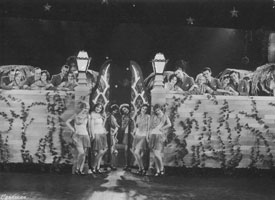 The lads then hurry drill-team style through the gate of the wall to join the girls, as another group of girls rush out to dance in front of the wall. The lads then hurry drill-team style through the gate of the wall to join the girls, as another group of girls rush out to dance in front of the wall.
The dancing becomes more frenzied & is a pure delight. The leggy girls' collegiate mini-skirts never cease to be startling to me since as a kid in the '60s I got it in my head boomers were the first generation to wear dresses as short as that.
The second number begins very sedate with men in suits straddling their chairs backwards, surrounding a young woman kneeling on the floor in voluminous gown.
She begins singing "It Was the Dawn of Love" in a voice that sounds like she's got a clothespin on her nose. The song had been a hit earlier in 1928 for Bing Crosby singing with the Paul Whiteman Orchestra, so the main attraction here would've been the song more than the singer.
This is Lyda Roberti of a Polish circus family. She travelled the world with her family circus early in the 1920s, performing as horseback rider & trapeze artist, finding her way to San Francisco & Los Angeles by the mid-1920s as chorus girl.
The male chorus surrounding her creates a better vocal sound than she does, but that's not saying much.
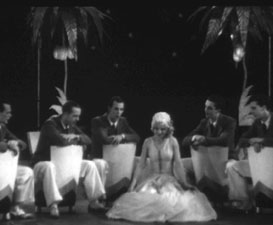 Her cartoon-character voice makes it funnier than intended. But when the chairs are shoved aside & the lads begin dancing with Lyda, her greater charms are soon evident. It's all quite fun even if the song isn't much. Her cartoon-character voice makes it funnier than intended. But when the chairs are shoved aside & the lads begin dancing with Lyda, her greater charms are soon evident. It's all quite fun even if the song isn't much.
By 1928 when she made this Vitaphone one-reeler, she was barely famous enough as a great beauty to be given star billing. She would have a small film career with Paramount in the early '30s, playing vamps, & then for MGM & Hal Roach would play comedy roles in which her heavy Polish accent causes mutual confusion.
She's probably best remembered today for parodying Greta Garbo in Million Dollar Legs (1932) starring W. C. Fields & Jack Oakie. She & Oakie became fast friends; he said he liked her because she was a quick wit & they shared similar senses of humor.
She missed out on an important role in Roberta (1935) which went to Ginger Rogers, but Lyda had originated the role on Broadway, & it's been said Ginger copied Lyda's performance very closely.
Who is to say but that she might've become a top comic actress but for a weak constitution that caused her periodically to be unable to work. She died rather young, in 1938, of heart disease.
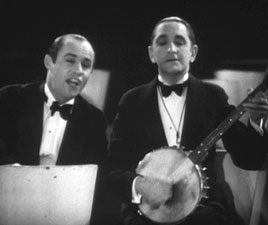 Next up, a comedy singer is accompanied by another fellow on banjo. These two guys were billed as Bailey & Barnum, stars of a handful of other one-reel films, The Globe Trotters (1928), Two White Elephants (1928), & Without a Band (1929). Next up, a comedy singer is accompanied by another fellow on banjo. These two guys were billed as Bailey & Barnum, stars of a handful of other one-reel films, The Globe Trotters (1928), Two White Elephants (1928), & Without a Band (1929).
Bill Bailey is believed to be the very fellow who inspired the 1902 hit song "Won't You Come Home Bill Bailey. He & David Barnum doubtless selected their stage names intentionally to evoke the circus name.
Bailey sings the lyric to the momentarily gay-sounding: "Ship ship ahoy, I just met a boy today/ He'd been away a year over in Bombay/ I knew why he'd been away so long/ When he started singin' me this song:
"Pretty little bom-bom Bomb from bom Bombay/ On a little tom-tom tom-to-tom she would play/ Underneath the yum-yum yum-yum tree we'd dance & sway..." & so on with plenty of childish word-repetitions.
These guys are pretty good, but they wouldn't be a high note to end the film on. So cut to a stage with what I presume were supposed to be Hindu divinities. One statue looks more like a Japanese hell-god. The one in the middle looks like a Conan the Barbarian but with (no kiddin'!) a prairie dog's head!
A long chorus line of girls with bathing suits & clunky shoes are in front of the statues. They're doing a precision-dance to "The Doll Dance." This presages the conga line fad of a later decade.
This is followed by "swimming motions" choreography, & other cute but not especially talented moves. This is stretched out quite a long while, concluding with an undulating centipede bit. I liked the fact that none of these gals is anorexic, which was not the preferred body image of the era.
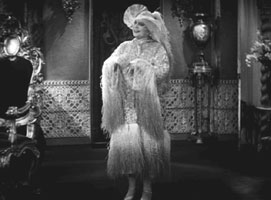 Trixie Friganza (nee Delia O'Callahan) began playing character roles in the silent movies. Trixie Friganza (nee Delia O'Callahan) began playing character roles in the silent movies.
She performed in comic operas in the 1890s & early 1900s, rising in fame until she had her own comedy act on the vaudeville circuit. She recorded comedy songs & had a giant hit with "Hello, Central," a typically comedic talk-song which made those two words "Hello, Central" a popularly parroted catchphrase for decades to follow.
She had a serious side, being an activist for numerous social causes, notably suffrage, as women did not have the national vote until 1922. She frequently performed at benefit fundraisers for the poor.
Reputedly when still young & doing comic operas she'd been slim & pretty, but by the time she had her own act she was stout, & later still when she filmed My Bag o' Tricks (aka, My Bag of Trix, 1929), she was physically a fatter more matronly Mae West type.
A bit of My Bag of Tricks could not be restored due to nitrate composition, although the sound (which Vitaphone recorded separate from the film on a disc) survived intact. So this film begins with a freeze-frame of Trixie Friganza, waiting to start moving when the sound reaches the recovered film.
In this opening bit called "Leave the Room, John," we hear her telling a tale about a five year old boy named John & his mother, who seems a mite abusive to the kid. When the story gets to the part about mom's drunkenness, the freeze-frame begins to move.
The "joke" of the tale she narrates is that she spells all the stuff about boozing it up, so that little John won't understand mommy's been having a drunken good time with B-E-N-N-Y who isn't her husband, assuming the whole while that little John's just too little to know what's spelled. But of course he understands it all.
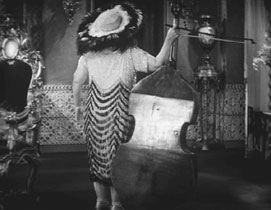 Concluding this mildly amusing bit, she takes off a couple layers of her excessive costume, & drags out a bass viola as big as her big self, opens the door in the back of it, takes out a hat to wear, coughs, groans, laughs, then begins another talk-song about never finding the right man, while pretending to bow the instrument. Concluding this mildly amusing bit, she takes off a couple layers of her excessive costume, & drags out a bass viola as big as her big self, opens the door in the back of it, takes out a hat to wear, coughs, groans, laughs, then begins another talk-song about never finding the right man, while pretending to bow the instrument.
She finishes the talk-song with a lyric about killing her husband entitled "The Peevish Widow," then turns around & asks us to compare the shape of the bass viola with her shape.
Then using the bass as a drum she talk-sings a third novelty number, with such crappy lyrics I have to quote them entire: "A little girl named Lulu/ When down to Honalulu/ To learn to do the Hula/ Hula hoo!/
"But one day little Lula/ Broke her hula-hula/ When she fell upon her wicky-wacky-woo/ Now this little girl named Lulu/ Who went to Honalulu/ Who learned to do the hula hula hoo/ No more can do the hula/ Poor little Lula/ Poor Hula Lula/ Is all black & blue-la/ Riggy-diggy-dumma-diggy-dum, dum-dum."
Bad as the writing for that routine is, Trixie's so lively & bizarre that she forces it to be entertaining, whacking on her bass with that bow & jiggling her fat, she's just kind of cool.
Her last number is about a guy who believes in eugenics & mistakes himself for the perfect man, but was only "a great big piece of cheese." He had a temper & liked to get in fights, until one fine day he foolishly hit Trixie, & she killed him like she killed one of her husbands. The end.
Continue to:
Even More Vitaphone Shorts among the extras
with the Jazz Singer 80th Anniversary Deluxe Edition
copyright © by Paghat the Ratgirl
|
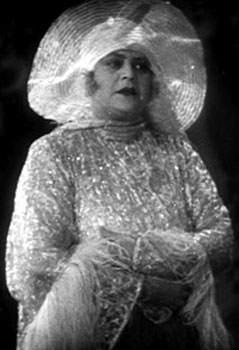
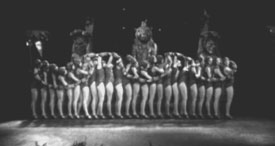
 The lads then hurry drill-team style through the gate of the wall to join the girls, as another group of girls rush out to dance in front of the wall.
The lads then hurry drill-team style through the gate of the wall to join the girls, as another group of girls rush out to dance in front of the wall. Her cartoon-character voice makes it funnier than intended. But when the chairs are shoved aside & the lads begin dancing with Lyda, her greater charms are soon evident. It's all quite fun even if the song isn't much.
Her cartoon-character voice makes it funnier than intended. But when the chairs are shoved aside & the lads begin dancing with Lyda, her greater charms are soon evident. It's all quite fun even if the song isn't much. Next up, a comedy singer is accompanied by another fellow on banjo. These two guys were billed as Bailey & Barnum, stars of a handful of other one-reel films, The Globe Trotters (1928), Two White Elephants (1928), & Without a Band (1929).
Next up, a comedy singer is accompanied by another fellow on banjo. These two guys were billed as Bailey & Barnum, stars of a handful of other one-reel films, The Globe Trotters (1928), Two White Elephants (1928), & Without a Band (1929).
 Concluding this mildly amusing bit, she takes off a couple layers of her excessive costume, & drags out a bass viola as big as her big self, opens the door in the back of it, takes out a hat to wear, coughs, groans, laughs, then begins another talk-song about never finding the right man, while pretending to bow the instrument.
Concluding this mildly amusing bit, she takes off a couple layers of her excessive costume, & drags out a bass viola as big as her big self, opens the door in the back of it, takes out a hat to wear, coughs, groans, laughs, then begins another talk-song about never finding the right man, while pretending to bow the instrument.